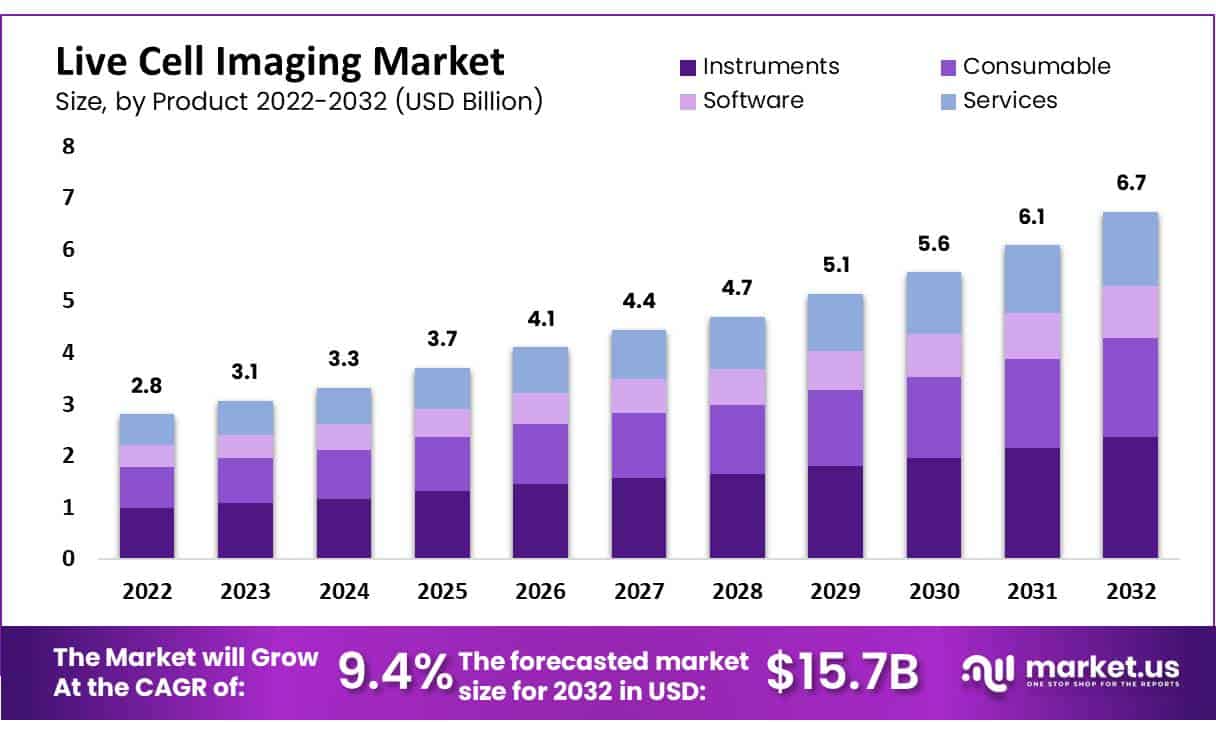Table of Contents
Introduction
The Global Live Cell Imaging Market, valued at USD 2.8 billion in 2022, is projected to reach USD 6.7 billion by 2032, growing at a CAGR of 9.4% from 2023 to 2032. This sector is witnessing rapid growth due to significant advancements in imaging technologies and an increasing demand for real-time cellular analysis. High-resolution microscopy techniques such as laser-scanning confocal, multiphoton, and spinning-disk confocal imaging are pivotal. These methods provide deeper insights into cellular functions, enhancing research capabilities crucially.
Further driving market expansion are enhancements in imaging software, which facilitate 3D reconstruction and automated image analysis. This evolution allows for more detailed and quantifiable cell analysis, enabling complex procedures previously unfeasible. Such technological progress is accelerating the adoption of live cell imaging tools across various research settings.
Live cell imaging is increasingly utilized in crucial fields such as stem cell research and regenerative medicine. For example, it has been instrumental in studies where fasting induces metabolic shifts in intestinal stem cells, boosting their regenerative abilities. This application highlights the potential of live cell imaging to advance understanding of cellular processes and develop new therapeutic strategies for age-related ailments and tissue repair.
Support from academic and research institutions also plays a critical role in this growth. Facilities like those at UT Southwestern provide essential resources, ensuring researchers have access to advanced imaging tools. This support helps propel the sector forward by enhancing research capabilities and opening new avenues for biomedical exploration and therapeutic development.

Key Takeaways
- In 2022, the live cell imaging market reached a valuation of US$ 2.8 billion.
- By 2032, projections show this market could increase to US$ 6.7 billion.
- An estimated compound annual growth rate (CAGR) of 9.4% is expected from 2023 to 2032.
- The Instruments segment currently dominates the live cell imaging market in terms of market share.
- The Consumables segment is anticipated to grow at the highest CAGR in the upcoming years.
- Cell Biology emerges as the primary application in live cell imaging.
- Fluorescence Resonance Energy Transfer (FRET) technology leads with the largest market share.
- Pharmaceutical and Biotechnological Companies are the major end-users in this market.
- North America is the market leader in live cell imaging by regional share.
- The Asia-Pacific region is predicted to witness the fastest market growth.
- Key industry players include Danaher Corporation, Nikon Corporation, and Olympus Corporation.
Emerging Trends
- Multimodal Imaging Techniques: The fusion of optical fluorescence microscopy (OFM) with X-ray fluorescence microscopy (XFM) marks a significant advancement. This integration allows researchers to extract a wealth of information from a single cell sample, enhancing our understanding of molecular interactions within cells. By combining these imaging techniques, scientists can observe cellular processes in greater detail, aiding in more accurate biological assessments.
- 3D Bioprinting in Imaging: The application of 3D printing technology in live cell imaging is increasingly significant, particularly for creating test objects known as “phantoms” used in PET scans and other imaging tools. These phantoms are crafted with different concentrations of radioactive solutions and are crucial for the standardized calibration and quality assurance of imaging equipment. This innovation enables more precise studies of molecular dynamics and interactions, paving the way for breakthroughs in medical research and diagnostics.
- AI-Enhanced Imaging: Artificial intelligence is transforming live cell imaging by enabling the analysis of extensive data sets with unprecedented accuracy and efficiency. AI applications in imaging help in identifying patterns and anomalies in cellular functions, particularly useful in complex fields like genomics and disease pathology. This trend is steering live cell imaging towards more personalized medical treatments and monitoring, promising significant impacts on future healthcare solutions.
Use Cases
- Drug Discovery and Development: Live cell imaging is essential in drug development. It tracks the real-time impact of drugs on living cells. This technique is crucial for studying how drugs interact at the cellular level, affecting their development and approval. By providing detailed insights into both the pharmacodynamics and pharmacokinetics, it helps predict the efficacy and safety of medications. This process is vital before moving to clinical trials, ensuring only the most promising compounds progress.
- Disease Research and Diagnostics: Live cell imaging is a powerful tool in disease research. Scientists use it to observe cellular reactions to various stimuli or conditions continuously. This capability allows them to pinpoint how diseases evolve and affect cell functions. By understanding these mechanisms, researchers can identify new therapeutic targets and enhance diagnostic accuracy. This detailed observation helps in developing more effective treatments and understanding complex disease pathways.
- Personalized Medicine: Personalized medicine benefits significantly from live cell imaging. This technology helps customize treatments by analyzing how individual patient cells respond to different therapies. Such tailored approaches lead to more effective treatment plans with fewer side effects. By directly observing cellular responses, doctors can choose the best therapeutic strategies for each patient, improving overall treatment outcomes.
- Educational and Research Tool: In educational settings, live cell imaging is invaluable. It allows students and researchers to watch cellular processes unfold in real time. This exposure is crucial for a deeper understanding of cell biology and its applications. It not only enhances learning but also supports advanced research, making it a fundamental tool in both academic and scientific communities.
Conclusion
The global live cell imaging market is poised for substantial growth, driven by technological advancements in imaging techniques and software. These enhancements have revolutionized the study of cellular processes, contributing significantly to fields such as stem cell research and regenerative medicine. With the support of academic and research institutions, the sector continues to thrive, facilitating breakthroughs in biomedical research and therapeutic developments. As tools become more sophisticated and accessible, the integration of artificial intelligence and multimodal imaging techniques is expected to further refine diagnostic capabilities and accelerate the discovery of new treatments. This evolving landscape indicates a promising future for live cell imaging, underlining its critical role in advancing healthcare and medicine.
Discuss your needs with our analyst
Please share your requirements with more details so our analyst can check if they can solve your problem(s)



